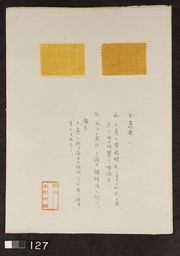Onion
Jump to navigation
Jump to search
Description
A round edible bulb, Allium cepa, whose outer skins have been used to produce a dye. The dried skins are removed from the onion and boiled in water to produce shades of yellow, brown, and green. The flesh of onions makes a paler yellow and young sprouts give a vivid yellow. Historically, onion skins have been used for dyeing by the ancient Greeks, Persians, Egyptians, and African tribes.
- See also [Uemera Dye Archive (Tamanegi)]
Synonyms and Related Terms
Allium cepa; Natural Yellow 10; Zwiebel (Deut.); cebolla común (Esp.); oignon (Fr.); cipolla (It.); ui (Ned.); cebula zwyczajna (Pol.); cebola (Port.); gul lök (Sven.)
Resources and Citations
- R.J. Adrosko, Natural Dyes in the United States, Smithsonian Institution Press, Washington, DC, 1968
- Helmut Schweppe, Schweppe color collection index and information book
- J. Thornton, 'The Use of Dyes and Colored Varnishes in Wood Polychromy', Painted Wood: History and Conservation, The Getty Conservation Insitute, Los Angeles, 1998
- Wikipedia: http://en.wikipedia.org/wiki/Onion (Accessed Mar. 20, 2006) -for non-English terms
- G.S.Brady, Materials Handbook, McGraw-Hill Book Co., New York, 1971 Comment: p. 852
- Random House, Webster's Encyclopedic Unabridged Dictionary of the English Language, Grammercy Book, New York, 1997
- The American Heritage Dictionary or Encarta, via Microsoft Bookshelf 98, Microsoft Corp., 1998
